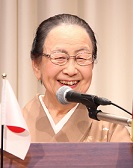Satake Version of 36 Immortal Poets—Their Portraits and Tanka-Poems
November 20, 2019
Ms. Akiko Baba
Tanka Poet
�� ��Satake Version of 36 Immortal Poets—Their Portraits and Tanka-Poems�� are now exhibited at Kyoto National Museum. 36 tanka-poems were selected by Fujiwara no Kintou (10~11th century), an exemplar of Japanese poetic ability, who lived in the same age with Murasaki Shikibu, the author of the Tale of Genji. Portraits were painted about 200 years later in early Kamakura Period (13th century) by Fujiwara no Nobuzane, an artist and tanka-poet. There were no photos of poets as there were no cameras in those days. Nobuzane kindled his imagination from tanka poems composed of only 31 syllables: 5,7,5,7,7 by each of 36 poets and two exquisite horizontal picture scrolls were completed.
��Satake Version of 36 Immortal Poets—Their Portraits and Tanka-Poems�� are now exhibited at Kyoto National Museum. 36 tanka-poems were selected by Fujiwara no Kintou (10~11th century), an exemplar of Japanese poetic ability, who lived in the same age with Murasaki Shikibu, the author of the Tale of Genji. Portraits were painted about 200 years later in early Kamakura Period (13th century) by Fujiwara no Nobuzane, an artist and tanka-poet. There were no photos of poets as there were no cameras in those days. Nobuzane kindled his imagination from tanka poems composed of only 31 syllables: 5,7,5,7,7 by each of 36 poets and two exquisite horizontal picture scrolls were completed.
��The two picture scrolls drifted from Kyoto to Marquis Satake, a feudal lord of the Akita Clan. Later during the Taisho Period in 1919, exactly 100 years ago from now, the Satake Family wanted to sell the Scrolls out of necessity and had them appraised by experts. It turned out to be so expensive, even higher than the national budget of the time. Masuda Donnou, an industrialist and superb tea ceremony master in Odawara, summoned 36 industrialists and art lovers, cut the scrolls into 36 separate pieces and let them choose one by drawing lots. They changed hands during the past 100 years and some of them are missing, so only 31 are exhibited now in Kyoto.
��Kakinomoto no Hitomaro is the first poet. His poem means: ��Against the dawning sky, a little row boat is leaving the Inlet of Akashi, in the morning fog.�� This poem is not actually by Hitomaro, because in Man��youshou (Collection of Ten Thousand Leaves), the oldest extant collection of tanka edited in Nara Period (8th century), it is anonymous. In those days, superb anonymous tanka was named after renowned poets or emperors. A portrait of Hitomaro is painted in a very relaxed manner sitting cross-legged, holding a brush in one hand and paper in the other wearing a casual kimono, but with sharp piercing eyes.
��Ariwara no Narihira is well-known as an amorous and handsome man, but had a hapless fate. He was a grandson of Emperor Heizei, who disputed with his half-brother Emperor Saga and all the relatives were executed. At the cherry blossom viewing party, he composed a poem which reads ��If there were no cherry blossoms in this world, my mind in the springtime would be more peaceful.�� Everyone present there, shed tears, because if you replace ��cherry blossoms�� with something else, for example ��the Fujiwara Family��, it would be poignant metaphor. The Fujiwara Family dominated the imperial government from the 9th to the 12th century, by shrewd intermarriage and diplomacy, and Narihira was separated from his lover, the daughter of Fujiwara who was maneuvered to become Emperor Seiwa��s wife.
��Next, Onono Komachi, who was said to be extremely beautiful. ��Flowers are fugitive and ephemeral, so are the minds of people in this world�� is her poem. As Nobuzane had never seen Komachi, after careful thought he painted her from the back. Beautiful many-layered kimonos and abundant long black hair were symbols of beauty in those days. She engaged in many romantic affairs and made poetry exchanges, but was repeatedly betrayed by men and society. According to a legend, she lost all her beauty in later years and was hanging about on the street as a beggar, a harsh consequence of her earlier mistreatment of her lovers.
��Lastly, the poem by Fujiwara no Kanesuke of early Heian period, whose daughter Soushi became koui (lady of the bedchamber) of Emperor Daigo. In those days, emperors had many consorts, ladies in the court and koui. Kanesuke��s mind was extremely troubled and could not sleep wondering how Soushi had been treated by the Emperor, if the Emperor loved her and constantly worrying. He composed a poem and offered it to the Emperor: ��The mind of a father is not blind, but when it comes to his own child, love blinds and troubles him��. The Emperor was so impressed by his paternal love to his daughter and one night he summoned Soushi to his bed chamber. Soushi was conceived and gave birth to Prince Shoumei. If Kanesuke wrote a letter to the Emperor, not a poem, it could not have worked so well. It was the power of a poem. The portrait of Kanesuke looks very gentle but with a humble attitude as if imploring the Emperor to take good care of his daughter.
��I feel we are extremely lucky to be able to enjoy such exquisite portraits painted 800 years ago with their poems composed more than 1,000 years ago. Please visit Kyoto to see the exhibition. If you miss the chance this time, you might not be able to see them for the next half a century or even a century.